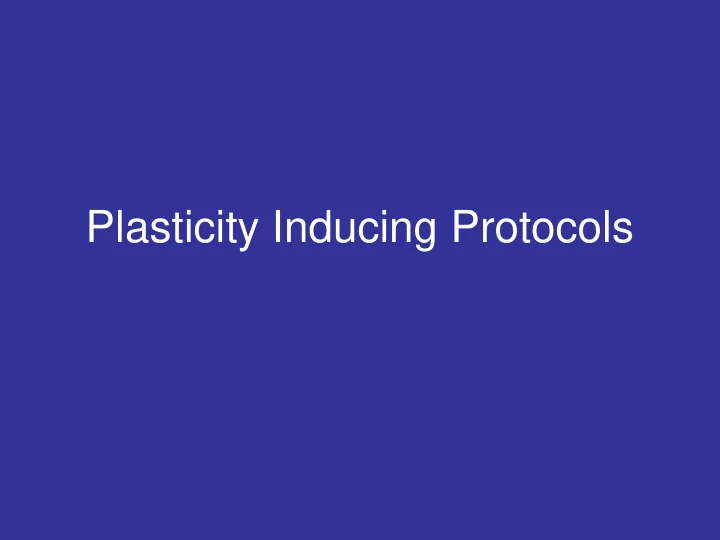

Plasticity Inducing Protocols
Plasticity: TMS Operational Definition Plasticity: “The brain’s ability to constantly change, grow and reorganize over the course of a lifetime.” Any change in the outcome measure that outlasts the TMS application can be thought of as a plastic response of the brain.
Noninvasive Protocols that Lead to Plastic Changes • TDCS • Conventional rTMS protocols • Patterned rTMS protocols • Paired Associative Stimulation Protocols • Combinations
tDCS • Anodal = generally facilitatory • Cathodal= generally inhibitory
rTMS protocols
Effects of Conventional rTMS Maeda et al., 2000
Theta Burst Stimulation – Theta Burst stimulation • 3 Pulses of TMS at 50 Hz with a 200 ms Intertrain Interval (total of 200 trains) – Continuous Theta Burst Stimulation (190 sec) – Intermittent Theta Burst Stimulation (40 sec) • 2 seconds (10 trains) repeated every 10 seconds Huang et al., 2005
Why Theta Burst Stimulation? • Rat Hippocampal cells fire in bursts of theta frequency during learning. • Human EEG Theta frequency increases during learning. • Time course similar to LTP and LTD in slice preparations • Modulated by GABA and Glutamate, like LTP and LTD.
Theta Burst Stimulation • Effect of TBS Huang et al., 2005
Computational Model of effects of TBS Huang et al., 2011
TBS in Aging
TBS in clinical populations A B 1.60 1.40 iTBS cTBS 1.50 1.30 [ proportion of baseline] [ proportion of baseline] 1.40 Red= individuals with 1.20 MEP amplitude MEP amplitude 1.30 autism 1.10 1.20 Blue= healthy 1.10 1.00 Baseline 1.00 Baseline 0.90 controls 0.90 0.80 0.80 ASD 0.70 Controls 0.70 cTBS 0.60 0.60 15 30 45 60 75 90 105 120 5 10 20 30 40 50 60 75 90 105 120 Time after TBS [ min] Time after TBS [ min] C 1.30 cTBS Green= individuals 1.20 [ proportion of baseline] with schizophrenia MEP amplitude 1.10 Blue= healthy Baseline 1.00 controls 0.90 0.80 0.70 5 10 20 30 40 50 60 75 90 105 120 Time after TBS [ min]
TBS and exercise
CON=control RUN=running EEO=enriched environment (only) EER=enriched environment +running (Mustroph et al, 2012; Kobilo et al, 2011)
Running enhances LTP • Training dose=4.7km±0.41 • Over 10 days • Neurogenesis • Morris water maze (van Praag et al, 2009)
Paired Associative Stimulation: Sensory-Motor Plasticity 90 pairs ISI 25 ms 90 pairs ISI 10 ms Stefan et al., 2000
What you should know… • Effects are influenced in both duration and direction by: – Intensity of Stimulation – Duration of Stimulation – Location of Stimulation – Sensitivity of outcome measure – Time of Day (Sale et al., 2007) – Attention (Stephan et al., 2004) – Hormones (Smith et al., 1999) – Brain State • Inter and intra-individual differences: – 1 Hz can be facilitatory in some individuals – Only approximately 50% of individuals respond to PAS – TBS has high intraindividual reliability, PAS does not.
Example of Brainstate affecting rTMS effect Lang et al ,2004 • 1mA 10mins tDCS • rTMS at 5Hz 100stim train at AMT – decreases SICI, but not lasting change in excitability as tested by single pulse TMS • Result= after effects of tDCS can generate opposite effects of rTMS or conversely can alter the after effects of tDCS
Step-by-Step Procedure • 1. Find hot-spot • 2. Find active motor threshold • 3. Baseline single-pulse measures • 4. TBS (cTBS or iTBS) • 5. Post-TBS assessments (single-pulse TMS) – T5 – T10 – T20 – T30
Recommend
More recommend